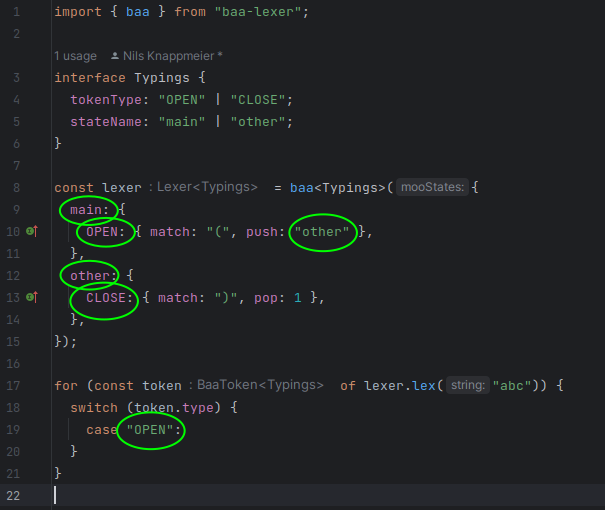Original image by lemmling on OpenClipArt.org
Baa!
Baa is a highly-optimised tokenizer/lexer written in TypeScript. It is inspired by moo , but completely rewritten.
It accepts most of moo's configurations, but lacks some features.
- No support for arrays of keywords.
- No support for rules that are arrays of rule definitions.
- No support for regular expressions with unicode flag
- Less dynamic checks (e.g. silently drops all provided regex flags)
Advantages:
- Compiles to a reusable concurrency-save lexer instead of creating an iterable object directly (see "Usage").
- Different token format.
- Slightly faster than
moo(at least not much slower) - About 2.2kb of size.
- Strong typings, including state-names and token-types
- Understandable code
Note: This was mostly an exercise for me to practice test-driven development and think about
architecture a bit. In the end, I tried to optimize speed and build size. I don't think it makes a
lot of difference whether you use moo or baa. moo is more popular and may be better supported in the long run.
I will use baa in handlebars-ng though.
Installation
Install the baa-lexer with
npm install baa-lexer
Usage
The examples/ show you how to use baa. One of the simple examples is this:
import { baa } from "baa-lexer";
const lexer = baa({
main: {
A: "a",
FALLBACK: { fallback: true },
B: "b",
},
});
for (const token of lexer.lex("a b")) {
console.log(token);
}This will print in the following tokens:
{ type: 'A', original: 'a', value: 'a', start: { line: 1, column: 0 }, end: { line: 1, column: 1 } }
{ type: 'FALLBACK', original: ' ', value: ' ', start: { line: 1, column: 1 }, end: { line: 1, column: 2 } }
{ type: 'B', original: 'b', value: 'b', start: { line: 1, column: 2 }, end: { line: 1, column: 3 } }
For a complete list of rules, have a look at the tests
Using types
If you create a type
interface Typings {
tokenType: "my" | "token" | "types";
stateName: "my" | "state" | "names";
}and pass it as generic to the baa function, you will get auto-completion for
types within the configuration as well as for the "type" field in the created tokens.
The following screenshot highlights all places that are type-checked and auto-completed.
Benchmarks
See performance/ for the exact tests and run then yourself with
yarn perf
These are the results, but be aware that results may vary a lot:
BENCH Summary
moo - performance/moo-baa.bench.ts > moo-baa test: './tests/abab.ts' (+0)
1.07x faster than baa
baa - performance/moo-baa.bench.ts > moo-baa test: './tests/fallback.ts' (+0)
1.19x faster than moo
baa - performance/moo-baa.bench.ts > moo-baa test: './tests/handlears-ng.ts' (+0)
1.50x faster than moo
baa - performance/moo-baa.bench.ts > moo-baa test: './tests/handlears-ng.ts' (1)
1.25x faster than moo
baa - performance/moo-baa.bench.ts > moo-baa test: './tests/handlears-ng.ts' (2)
1.19x faster than moo
baa - performance/moo-baa.bench.ts > moo-baa test: './tests/json-regex.ts' (+0)
1.15x faster than moo
moo - performance/moo-baa.bench.ts > moo-baa test: './tests/json.ts' (+0)
1.04x faster than baa
Readable / Extendable code
What bothered me most about moo was that it is just one large JavaScript file,
and it took me a long while to understand all the optimizations they implemented.
It tried to take modular approach. Basically the whole program is divided into
- The Lexer: Responsible for creating an IterableIterator of tokens which then manages state transitions. Uses the TokenFactory to create the actual tokens.
- The Matcher: Finds the next token match. There are different strategies
- RegexMatcher: Creates a large regex to find the next match
- StickySingleCharMatcher: Uses an array to map char-codes to rules. Can only find single-char tokens, but this can be done much faster than with Regex.
- The StateProcessor: Uses the Matcher to find the next match, interleaves matches for fallback and error rules.
- The TokenFactory: Keeps track of the current location and creates tokens from matches.
- The
mooAdaptertakes amoo-config and combines all those components so that they do what they should.
Advances usage
You do not have to use the mooAdapter though: Most the internal components are exposed, so
you can use them yourself. You can create a StateProcess and pass your own Matcher instance
to it. You can create a completely new StateProcessor with completely custom logic.
The program could also be extended to allow a custom TokenFactory, applying the token format that
you need (but I won't do this unless somebody needs it).


